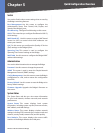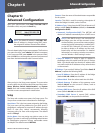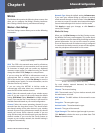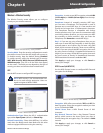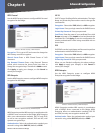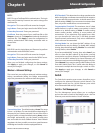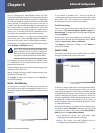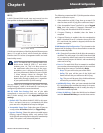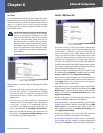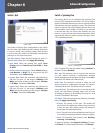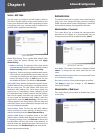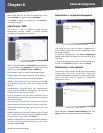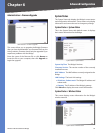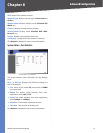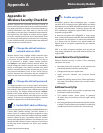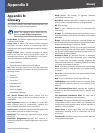
Chapter 6
Advanced Configuration
16
Wireless-G Business Ethernet Bridge
Port-Based
In port-based VLAN mode, the wireless bridge uses a port-
based VLAN map to limit the traffic between the ports. A
VLAN can include any of the five physical Ethernet ports
(ports 1-5) as well as port 6, which controls the wireless
interface and CPU access (management traffic and web-
based utility access).
NOTE: The default port-based VLAN settings
consist of connections between port 6 and
each of the five Ethernet ports. This is to allow
access to the web-based utility from any of
the Ethernet ports. In addition, the connection
between ports 1 and 6 is permanent and cannot
be changed. This ensures that you can always
access the web-based utility through at least
port 1, regardless of your particular port-based
VLAN settings.
Switch > VLAN - Port-Based
Output Vector Use these fields to configure your VLANs
as follows:
Each row of the table corresponds to one of the ports. 1.
For each port, specify its connections by selecting
all of its exit ports. For example, to specify a VLAN
connection from port 1 to port 2, select 2 in the row
labeled Port 1.
Each exit port you select specifies a unidirectional 2.
connection only. (In the example in step 1, the direction
is from port 1 to port 2.) To automatically add the
connection in the opposite direction (from port 2 to
port 1 in the example), click Configure Bi-directional
.
When you are finished defining the connections for 3.
the VLAN(s), click Apply Port VLAN Settings to save
and activate your VLAN configuration.
Switch > MAC Based ACL
Switch > MAC Based ACL
An Access List (ACL) is a list of source MAC addresses that
is used to grant or deny access. If a packet passes from the
wireless port to a LAN port or vice versa, the Bridge will
check if the packet’s source MAC address matches any
entry in the access list, then use the match result to pass
or drop the packet. However, packets from LAN port to
LAN port are not checked. You can select from two types
of Access Lists. A Block list blocks specific MAC addresses
specified in the table; all other MAC addresses are accepted.
An Accept list only accepts the MAC addresses listed in the
table; all other MAC addresses are blocked.
Access List Type To disable the Access List feature, keep
the default setting, Disabled. To enable Access Lists, select
Accept or Block, then click Apply Global Setting.
If you choose to use an Accept list, you must remember to
include your computer’s MAC address in the list before you
click Apply. Failure to do so may result in your computer
being denied access to the device.
New Block Entry To block packets with a specific MAC
address, enter the MAC address in this field, and click Add
Block Entry. To unblock the MAC address, enter the MAC
address in the field, click Delete Block Entry, then click
Apply Global Setting.
Block List Displays a list of blocked MAC addresses and
number of packets dropped for each address.
New Accept Entry To accept packets with a specific MAC
address, enter the MAC address in this field, and click Add
Access Entry. To unaccept the MAC address, enter the
MAC address in the field, click Delete Access Entry, then
click Apply Global Setting.
Accept List Displays a list of accepted MAC addresses
and number of packets accepted for each address.
Drop Count, Accept Count When Access List is enabled,
these display the total number of packets dropped and
accepted. Click Refresh to display the latest information.



